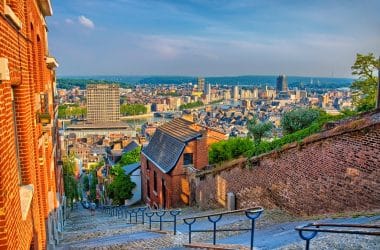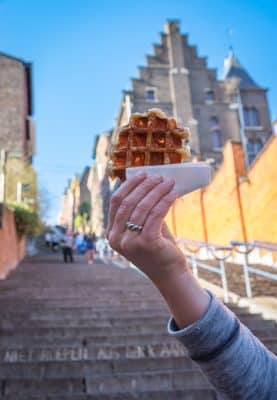Many travellers travelling from Germany to Paris, northern France or Belgium pass through Liège on their way, but make a stopover here at most. It is well worth planning a longer stay in the lively city in the east of Belgium, for example as a city trip over a long weekend or in combination with a nature and hiking holiday in the Ardennes. With just under 200,000 inhabitants, the second largest Walloon city is considered the cultural centre of the Walloon region and at the same time forms the core of the largest agglomeration in this part of Belgium. Her French name is Liége, the Dutch is Luik.
Already in Roman times an important cultural and political center
Liège’s role as the cultural and political centre of the region, including the capital of the province of Liège and the seat of the diocese of the same name, dates back to Roman antiquity. The development of the town was favoured by its strategically important location at the mouth of the Ourthe into the Meuse and on important European trade routes. Today, Liège impresses with a large number of historical sights that are stone witnesses to the long and eventful history of the city. In addition, there are several museums – including the Grand Curtius museum complex, the aquarium and the Transport Museum – as well as other cultural institutions, as well as a wide range of shopping and dining options. A special attraction is the Sunday market “Marché de la Batte”, which stretches for several kilometres on the left bank of the Meuse.
What should not be missed on any visit to Liège

One of the places that should definitely be on the agenda when visiting Liège is undoubtedly the Old Citadel, high above the lower town, from which you can enjoy an impressive view. It can be reached via the 373 steps of the steeply ascending staircase “Montagne de Bueren”, which has recently become known beyond the borders of Liège through a remarkable action. During the Covid-19 pandemic, Belgian adventurer and explorer Louis-Philippe Loncke simulated an ascent of Mount Everest at this site. He climbed the facility a total of 135 times and carried a 15-kilogram backpack. Other places of interest that should be part of the “must” of a stay in Liège are the Gothic cathedral of Saint-Paul with its cathedral treasure, which can be seen in the museum attached to the church, as well as the churches of Saint-Jacques, Saint-Barthélemy and Saint-Denis. The latter is not only the oldest church building in Liège from the Romanesque period, but was originally part of the city fortifications. Particularly worth seeing are the prince-bishop’s palace on Place Saint-Lambert, which now serves as a provincial palace and seat of a court, as well as the market square, the baroque town hall and the university. For those interested in architecture, it is also worth taking a detour to some remarkable Art Nouveau buildings in Rue du Vieux Mayeur and Rue Léon Mignon. By the way, particularly beautiful views of the old town and correspondingly good opportunities for photography are available on a trip with one of the shuttle boats that operate on the Meuse.
Culinary specialities in Liège and the surrounding area

If you want to discover the peculiarities of the regional cuisine during your visit to Liège, you should not miss the taste of the famous Liège waffles. Another sweet speciality is the Café Liégeois, which has its origins here. The Liège syrup produced in the region is a thick juice made from apples and pears, which is heavily boiled down and used, among other things, to season various dishes. An example of this is the Liège meatballs. They are served with a sweet and sour sauce made using Liège syrup. If you like it hearty, you should also try the Liège salad – consisting of green beans, potatoes, fried bacon cubes and chopped shallots. A local beer such as Jupiter or Piedbœuf goes well with it.
Easy to reach from Germany
For visitors from Germany, Liège is easily accessible thanks to its location in the east of Belgium and its very good integration into the European motorway network. If you live in the Rhineland, you can even easily choose the city as a destination for a day trip. The journey from Aachen takes less than an hour by car, and from Bonn, Düsseldorf or Cologne, the travel times to be planned are also manageable at around one and a half hours each. Rail passengers can choose between several daily connections to and from Aachen, Cologne, Brussels, Antwerp, Ostend, Luxembourg, Charleroi and Paris. Particularly noteworthy is the Liège-Guillemins train station, which now serves as Liège’s main train station. Around 500 trains run here every day, including international high-speed trains such as the Thalys and ICE International, as well as numerous regional train lines. With its wide, curved canopy in cantilevered construction, designed by the architect Santiago Calatrava, this station is not only an important railway junction, but also a special highlight of contemporary architecture.


